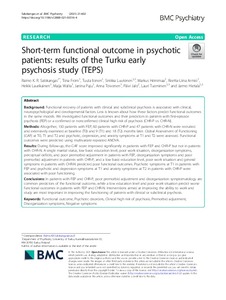Short-term functional outcome in psychotic patients: results of the Turku early psychosis study (TEPS)
Salokangas Raimo K. R.; From Tiina; Ilonen Tuula; Luutonen Sinikka; Heinimaa Markus; Armio Reetta-Liina; Laurikainen Heikki; Walta Maija; Paju Janina; Toivonen Anna; Jalo Päivi; Tuominen Lauri; Hietala Jarmo
https://urn.fi/URN:NBN:fi-fe2022012710845
Tiivistelmä
Background
Functional recovery of patients with clinical and subclinical psychosis is associated with clinical, neuropsychological and developmental factors. Less is known about how these factors predict functional outcomes in the same models. We investigated functional outcomes and their predictors in patients with first-episode psychosis (FEP) or a confirmed or nonconfirmed clinical high risk of psychosis (CHR-P vs. CHR-N).
Methods
Altogether, 130 patients with FEP, 60 patients with CHR-P and 47 patients with CHR-N were recruited and extensively examined at baseline (T0) and 9 (T1) and 18 (T2) months later. Global Assessment of Functioning (GAF) at T0, T1 and T2 and psychotic, depression, and anxiety symptoms at T1 and T2 were assessed. Functional outcomes were predicted using multivariate repeated ANOVA.
Results
During follow-up, the GAF score improved significantly in patients with FEP and CHR-P but not in patients with CHR-N. A single marital status, low basic education level, poor work situation, disorganization symptoms, perceptual deficits, and poor premorbid adjustment in patients with FEP, disorganization symptoms and poor premorbid adjustment in patients with CHR-P, and a low basic education level, poor work situation and general symptoms in patients with CHR-N predicted poor functional outcomes. Psychotic symptoms at T1 in patients with FEP and psychotic and depression symptoms at T1 and anxiety symptoms at T2 in patients with CHR-P were associated with poor functioning.
Conclusions
In patients with FEP and CHR-P, poor premorbid adjustment and disorganization symptomatology are common predictors of the functional outcome, while a low education level and poor work situation predict worse functional outcomes in patients with FEP and CHR-N. Interventions aimed at improving the ability to work and study are most important in improving the functioning of patients with clinical or subclinical psychosis.
Kokoelmat
- Rinnakkaistallenteet [27094]
